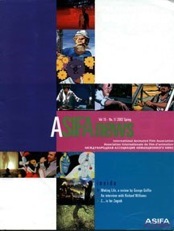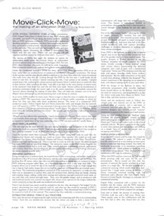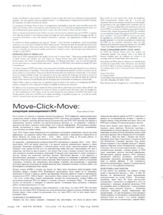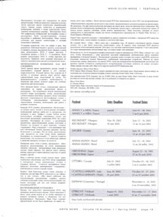ASIFA news, Vol. 15, No. 1, Spring 2002 p. 16-19 (English, French and Russian translations)
ASIFA NEWS, “MOVE-CLICK-MOVE: The making of an animation DVD”
by Wendy Jackson Hall
After several tentative years of format uncertainties, DVD (Digital Video Disc) is clearly here to stay. DVD players are affordable, and distributors are taking the format seriously, releasing films on DVD, sometimes exclusively. DVDs are an ideal medium to distribute and archive animation and short films in particular, because they can be used to hold artwork, text, and other materials in addition to film and video. They are small and lightweight, durable, and most importantly, digital, eliminating the problem of deterioration that occurs with film and video (where will your precious A/B roll negatives and Beta masters be 100 years from now?)
The success of DVDs has made the medium an option for independent media artists like Deanna Morse, an independent animator and university educator based in Michigan, USA. Her new DVD, MOVE-CLICK-MOVE, chronicles 30 years of her work, from short films to material created with students during artist residencies in schools.
Unlike the commercial animation DVDs out there, MOVE-CLICK-MOVE approaches DVD as an art form rather than just another means of commercial distribution and product promotion. The design of the interface and the many details added in addition to the short films reflect the vision of someone who really loves what they do. Looking through this DVD for the first time, I could hardly decide where to start first. As soon as I started watching one film, I was curious to see another. I jumped around quite a bit, exploring the various sections and features before I settled down to watch the films in their entirety. After watching the films, I was able to go back to the extra features to answer some of the questions I had about how and why the films were made. Morse’s selfless de-mystification of the animation techniques brings the viewer right into the artist’s experience. I particularly enjoyed the “process” photos detailing the making of some films. They will make any animator vow to be more diligent about photographing and documenting their work during its creation.
As an active ASIFA member or many years, Morse is eager to share her story to explain the process of making a DVD. The opportunity came about after one of Morse’s public screenings at which she shows her films, slides and talks about the production process. The owner of a DVD production studio, Trillion Digital, had seen Morse present her work and thought that her materials were well suited for a DVD. “He was interested in having a piece that Trillion could use to showcase their company’s DVD design and authoring talents,” recalls Morse, “He offered to do it for free during times when the company was between clients.” She agreed, and the two and a half-year production process began.
“When I was first offered this opportunity, I barely knew what a DVD was! There weren’t that many titles available three years ago. I found that when I discussed this project, and began the grant writing to support it, I spent most of my time explaining what a DVD was and could do!” recalls Morse.
SELECTION & PLANNING
“The first step was the most difficult,” she says, noting “It was not easy to commit to the finality of putting the work on a mastered DVD. I had two projects in post production, which I fast-tracked so they could be included.” In all, 36 short films were chosen to be included on the DVD.
Once she decided which films to include, the fun part began. Using note cards for each film, she brainstormed themes and concepts that could tie certain films together. She ended up with eight categories: Fun Shorts!, More Fun Stuff!, Dreams and Visions, Handspeak, Early Films, Visual Poems, Commercial Stuff, and Introduction. Then it was time to come up with the “extras,” the added features that make DVD such an appealing medium. The interactive nature of the DVD format begs for the kind of material Morse had to work with: slides, written materials, storyboards, artwork, experiments and of course, short films. She has diligently documented her filmmaking process all along, which gave her plenty of material to work with.
PREPARING MATERIALS
Poring through years of archived work, she found the best copies of everything and had the 16mm prints transferred to Beta SP at a local film laboratory, and the video materials converted right at Trillion. The resulting Beta SP master videos were then encoded from analog to digital (tape to computer) using a DVD authoring program called Sonic on a Macintosh computer with a very large hard drive. “The program allows you to tweak the size of the media as you digitize, so that you go at a high enough data rate to digitize high quality images, but not too high of a data rate (which jut takes up computer space),” says Morse. The multimedia programmer watched all of the material as he digitized it, to make sure that there was no degradation of quality. Next came the technical fixes, deleting drop-out frames, cleaning and cropping images, adding credits when missing and replacing copyright-protected music tracks on two early films with cleared and legal music. Then over 200 graphic images, such as production stills and storyboard panels were scanned into digital stills. Morse wrote captions for the images, behind the scenes comments on how the work was produced and animated.
Once it was decided how much would be included in the disc, they developed a bit budget for the project, determining how much material could fit and what size disc would be required. A DVD 5 holds 5 gigabytes of data, and a DVD 9 holds nine gigabytes. They determined that a DVD 9 would be required to hold all of the materials. This required that they undertake a commercial pressing.
INTERACTIVE DESIGN: TYING IT ALL TOGETHER
Next came the process of organizing the eight sections and connecting each film to its corresponding “extras.” Each film was divided into sections that the viewer can jump to from a menu from a representative still images that was pulled from the scenes. This feature is particularly helpful in presentations, eliminating the need to fast forward or rewind through scenes looking for just the right frames.
Five of the films feature “angles,” allowing the viewer to toggle between the finished film and the storyboard on screen. This required accurate timing of each storyboard still panel to match timing with finished production. And more than half of the films include production stills with captions describing challenges or elements distinctive to working with these various techniques.
Every DVD is like software in that it has to have a logical easy-to-use interface so that viewers can find all of the goodies that have been stashed inside. The graphic designer at Trillion decided to use the “desktop” metaphor to visually organize the DVD menus, literally creating a “messy desktop” image with various objects representing the different categories, and a pad of paper with a hand written “main menu.” Morse says “The desktop is a bit like my desk: with papers, drawings, shells, leaves, trinkets, and souvenirs. But the object placement on this desk is much more pleasing: cluttered, but designed.” The viewer’s experience is like snooping on an animator’s desk, with objects coming to live as you touch them.
With the design of the desktop in place, the multimedia programmer drew invisible highlight boxes around objects on the desktop, which defined the areas for interactivity and programmed it so that the viewer could jump from choice to choice, from film to film and from section to section.
Morse and the production team at Trillion also created some new material just for the DVD: an overview table of contents and a time-lapse of animation intercut with the film segments. The interface designer also created several “surprise” animations to appear at the beginning of each section.
Using the same graphics from the “desktop,” Grey Christian, the graphic designer, created an outer sleeve and program insert booklet for the DVD case. Morse says “I had several readers work on the printed materials with me. We spent a good bit of time trying to write clear captions and descriptions, and working on a simple “how-to” section for people new to navigating with DVDs.”
DUPLICATION AND PACKAGING
Before the DVD master could be made, they tested the final version. “We pressed a couple of DVDs and basically spent a week or so must clicking on every active button to make sure that things worked. Eric Oehrl, the multimedia programmer, is so meticulous, everything worked really well. I think perhaps we found one error in the whole testing process.” Then, the final DVD was transferred to DLT tape for replication.
“When this DVD was first conceived, we had thought about pressing only one copy for my use in presentations. But it turned out that with this quantity of material, the movies wouldn’t fit at high quality on a single disc. We decided to undertake a commercial pressing, which would allow for a dual layered disc. I began grant writing to support it.” Morse eventually received funding from her University and a discount offer from Digital Video Services in Grand Rapids, Michigan, to undertake the commercial pressing.
Digital Video contracted with a printer for the booklets and the inserts, and the DVD replicator pressed a glass master, printed the discs, inserted the printed materials, and shrink-wrapped the packages.
From start to finish, the process of creating MOVE-CLICK-MOVE took two and a half years, Morse says. “Many people came to this collaboration with the best they had to offer: they shared their art, they shared their skills, they shared their strengths. I feel honored by their gifts, and the final DVD reveals this positive energy. For me this DVD is a wonderful gift. It has it’s own life: it created an animated and interactive work for my animations to live in.”
Although she had the support of a professional DVD production studio, Morse believes that “It does not take a giant company with teams of folks and big budgets to speak with this medium.” An independent artist can now make their own DVD using home computers such as the new iMac, equipped with a DVD burner. Working on a computer with a DVD burner, an artist could “press” his or her own DVDs one at a time, but for large quantities, professional duplication is best. The cost of commercial DVD pressing is always fluctuating, but a general idea of pricing can be found on the Digital Video website.
Jackson-Hall, Wendy, “move-click-move,” ASIFA NEWS, Vol. 15, No. 1, Spring 2002 p. 16-19 (English, French and Russian translations)





